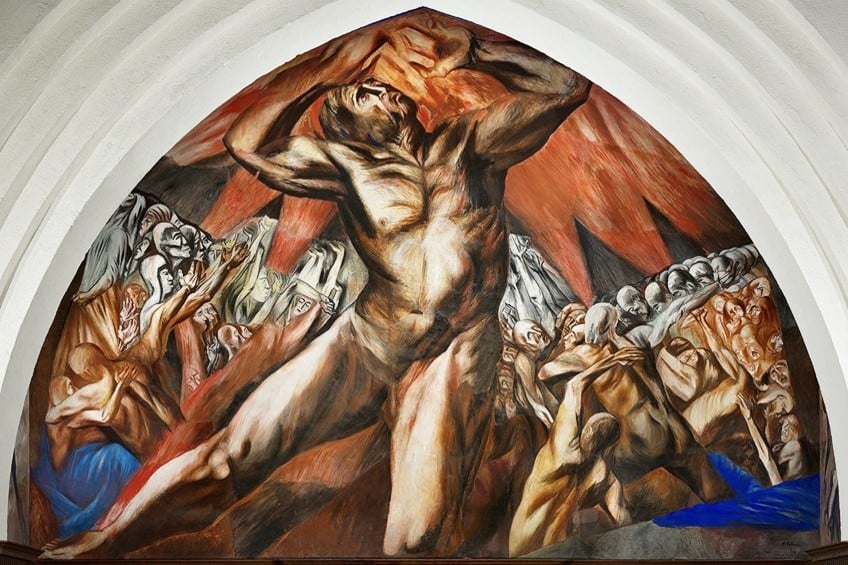Famous Mexican Paintings – A Look at Famous Mexican Art
Mexico possesses one of the Western hemisphere’s most distinct cultures, resulting in the creation of many famous Mexican artworks. Before the Spanish invasion completely changed the country, indigenous themes that date back to the 15th century heavily inspired Mexican art paintings. The many religious practices of the indigenous tribes who lived in Mexico were a significant topic of the famous art in Mexico in the 15th century and earlier. To understand the art of this region better, we will be looking at the most famous Mexican paintings to arise from this culturally rich country.
Our List of Famous Mexican Paintings
When Christianity spread throughout the region in the 16th century, Mexican artwork was irreversibly altered and became primarily representative of Christian principles and values. Despite centuries of Catholic control, the inhabitants of Mexico have never ignored the vivid flair and effects of the indigenous people who formerly called the country home.
Mexicans were free to once again pursue the unusual and bright varieties of Mexican artwork that appear to define the region after Spanish rule was removed in the early 1900s. Here is our list of the most famous art in Mexico.
Virgin of Guadalupe (1773) by Nicolás Enríquez
| Artist | Nicolás Enríquez (1704 – 1790) |
| Date | 1773 |
| Medium | Oil on copper |
| Dimensions (cm) | 56 x 42 |
| Location | Metropolitan Museum, New York, United States |
According to mythology, Mary manifested in Mexico before a 57-year-old Aztec believer in Christ named Juan Diego. She asked that a shrine be created in her honor at the location. Nevertheless, the archbishop demanded proof. When Juan Diego informed Mary about it, she encouraged him to walk to the summit of the hill and collect flowers.
Juan Diego discovered Castilian roses at the top of the hill, which was not native to the area nor in season.
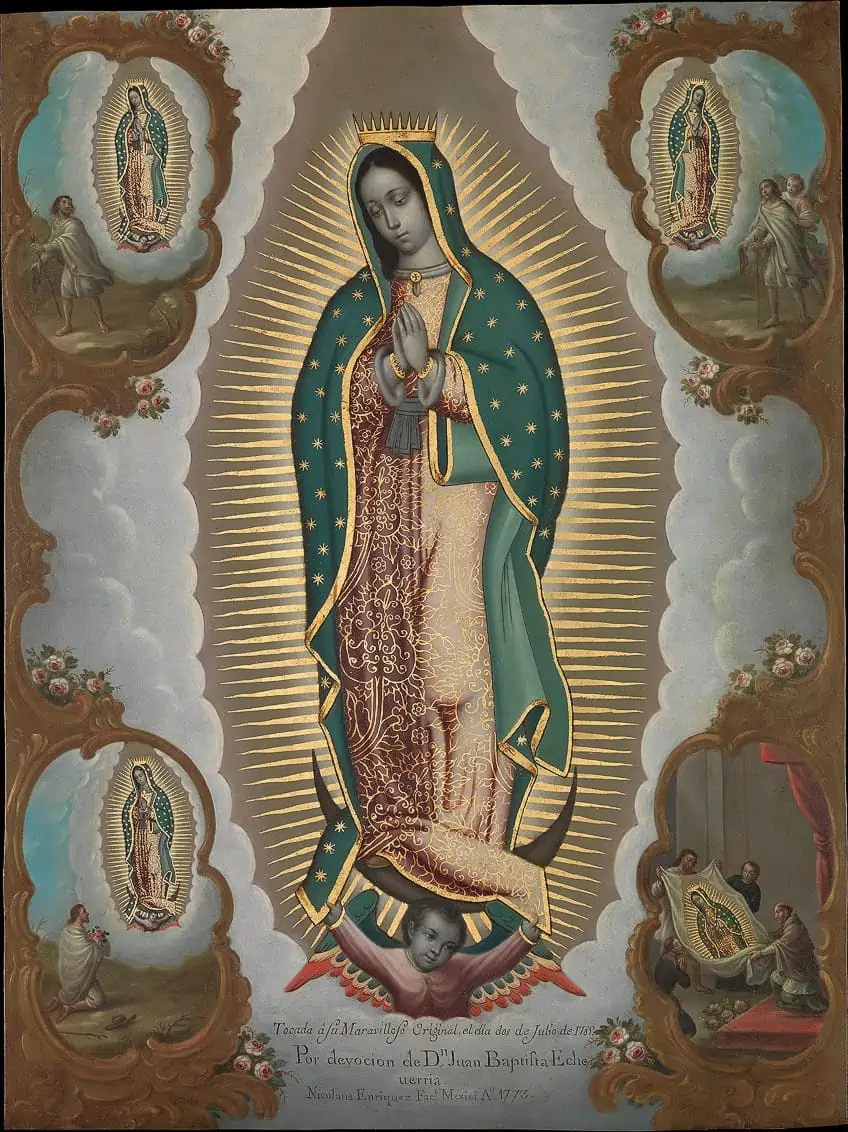
Mary placed the flowers in Juan Diego’s burlap robe herself. She then instructed Diego to only unravel the cloak upon his arrival at the bishop. When Diego did this, the blossoms fell to the floor, leaving the picture shown in the painting on the surface of the cloak. The artwork is presently housed in Mexico City’s Minor Basilica of Our Lady of Guadalupe.
It has become a cultural icon of Mexico, and the basilica has become the world’s most frequented Catholic pilgrimage site.
La Calavera Catrina (1913) by Jose Guadalupe Posada
| Artist | Jose Guadalupe Posada (1852 – 1913) |
| Date | 1913 |
| Medium | Zinc etching |
| Dimensions (cm) | 11 x 15 |
| Location | Multiple prints |
Because of his sarcasm, sensitivity, and social commitment, José Guadalupe Posada is regarded as a profoundly significant political printer and engraver. His most well-known painting features a tall, finely dressed female skeleton donning an ornately designed hat.
The odd contradiction draws attention to the country’s European and international influences.
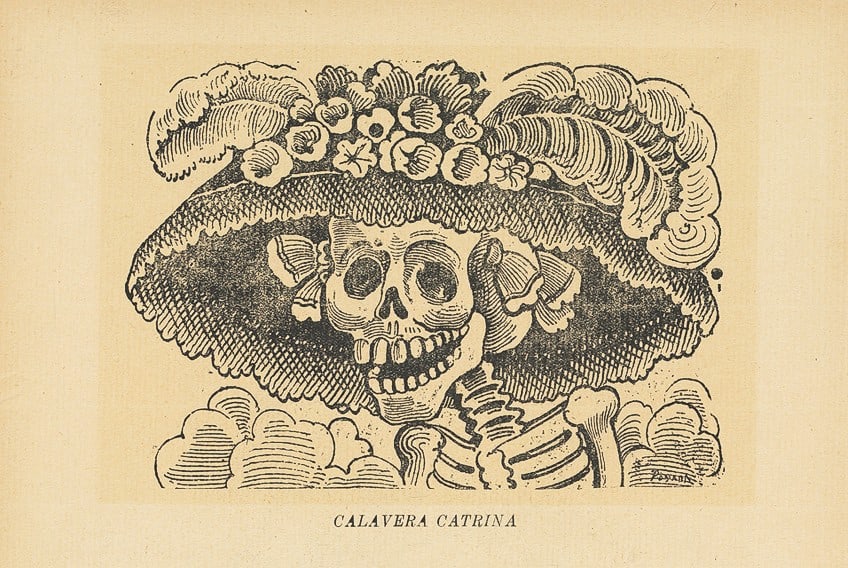
The image is seen as a sarcastic representation of Mexican residents who were embarrassed by their indigenous backgrounds and wished to imitate European customs. The Day of the Dead is a famous Mexican festival during which friends and relatives gather to honor loved ones who have died.
It has become a symbol of the Day of the Dead, and her incarnation is widespread at Day of the Dead celebrations around the country.
Prometheus (1930) by José Clemente Orozco
| Artist | José Clemente Orozco (1883 – 1949) |
| Date | 1930 |
| Medium | Fresco |
| Dimensions (cm) | 610 × 870 |
| Location | Frary Dining Hall, Pomona College, Claremont, California, United States |
Despite being poorly recognized in the States at the time, Mexican painter José Clemente Orozco went on to become renowned as one of the three great Mexican muralists, with Diego Rivera and David Alfaro Siqueiros. It was Orozco’s first large painting in the United States and the first fresco in the nation by a member of the three Great Mexicans.
The Mexican mural group’s growth outside of Mexico may be traced back to Pomona College.
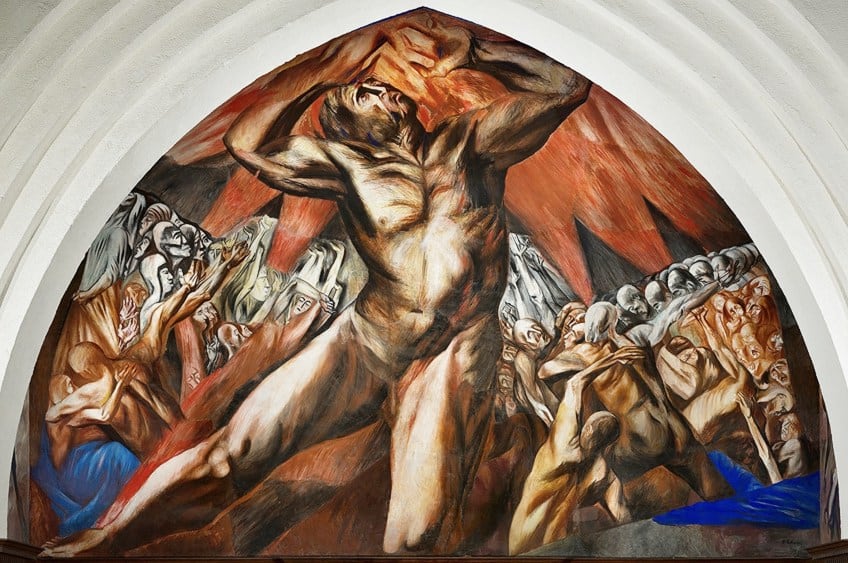
The proposal for a mural in Frary Hall was initially proposed by Sumner Spaulding, its architect, shortly after the dining hall was completed. Students from Pomona organized for Orozco to travel to Claremont, where he resided there for two months while painting the mural.
The History of Mexico (1935) by Diego Rivera
| Artist | Diego Rivera (1886 – 1957) |
| Date | 1935 |
| Medium | Mural |
| Dimensions (cm) | 700 x 90 |
| Location | National Palace, Mexico City, Mexico |
One of the most famous Mexican paintings was created as a mural on the main stairway of Mexico City’s National Palace, rather than on a canvas. The artist was well-known for his artworks that depicted historical settings, and this piece was started in 1929 and finished in 1935.
It comprises a plethora of scenes that characterized the country in essence, starting in what was deemed the native Aztec period and continuing into what was modern-day Mexico at the time Rivera created the piece.
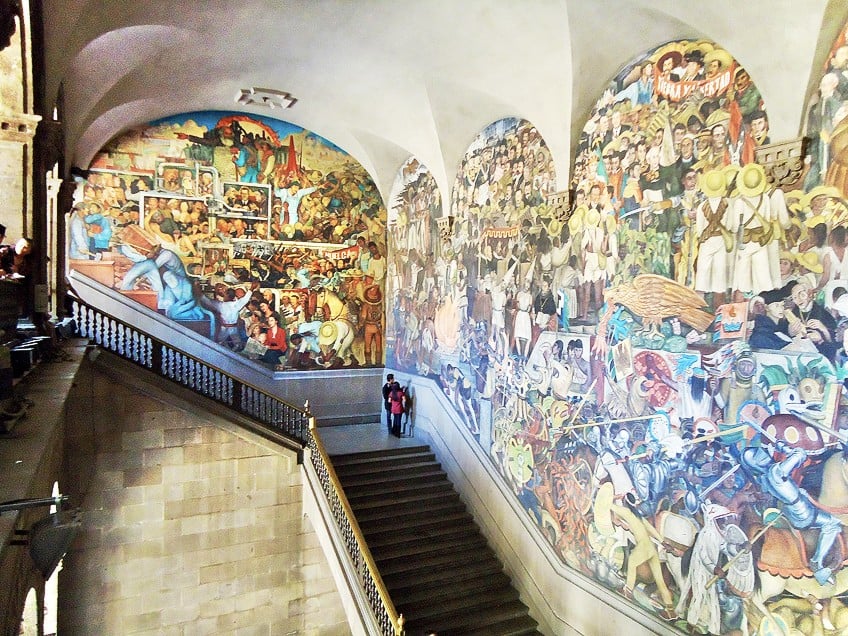
It represents the indigenous Mexicans being conquered by Christian dominance, as well as the centuries that proceeded under the Catholic faith. Rivera concentrated on the country’s war for liberation from Spain, and the famous Mexican artwork is filled with many great individuals who molded Mexico throughout its history.
The artwork is a huge masterpiece that brilliantly portrays many of the country’s hardships and successes.
Echo of a Scream (1937) by David Alfaro Siqueiros
| Artist | David Alfaro Siqueiros (1896 – 1974) |
| Date | 1937 |
| Medium | Enamel paint |
| Dimensions (cm) | 122 x 91 |
| Location | Museum of Modern Art, New York City, USA |
David Alfaro Siqueiros, together with José Clemente Orozco and Diego Rivera, is recognized as one of Mexico’s three great muralists. Siqueiros, the most extreme of the trio, is known for his images of human struggles against dictatorial states. His most renowned piece conveys the starkness, sorrow, and desolation of war.
It is a compelling piece that was produced during the Spanish Civil War that physically and symbolically conveys human misery throughout the war.
The artwork’s most noticeable figure is an oversized head of a sobbing baby, with another wailing baby emerging out of his mouth. Shells, shrapnel, and shattered canons, among other items, are scattered around the ground to depict the aftermath of combat.
It is widely recognized as one of the most well-known Mexican antiwar artworks.
Self-Portrait (Inn of the Dawn Horse) (1938) by Leonora Carrington
| Artist | Leonora Carrington (1917 – 2011) |
| Date | 1938 |
| Medium | Oil on canvas |
| Dimensions (cm) | 65 x 81 |
| Location | Metropolitan Museum of Art, New York, USA |
Surrealist influences have long been recognized in Mexican art, especially the works of Leonora Carrington. This 1938 picture depicts a weird situation in which a haggard Carrington sits in a chair confronting a female hyena. A rocking horse is mounted on a wall behind her, and the window in the distance depicts a gorgeous, charging white stallion.
The significance of this picture has long been debated by art fans and critics alike.
There have been very few scholars have been able to state for certain what Carrington meant to achieve with this piece, but the amount of mystery surely contributes to why this artwork is among the most renowned Mexican art paintings.
The Two Fridas (1939) by Frida Kahlo
| Artist | Frida Kahlo (1907 – 1954) |
| Date | 1939 |
| Medium | Oil on canvas |
| Dimensions (cm) | 174 x 173 |
| Location | Museo de Arte Moderno, Mexico City, Mexico |
Frida Kahlo is considered by many people to be the most well-known Mexican painter and among the best self-portraitists of all time. She had a turbulent romance with another well-known Mexican artist, Diego Rivera, in which they wedded, separated, and rejoined several times.
This famous Mexican artwork was made around the time of Kahlo’s separation from Diego Rivera and is thought to depict her sorrow. It’s a self-portrait in two parts.
The one version of Kahlo on the left is dressed in a European-style white gown with her heart wounded and bleeding, while the other Kahlo on the right is dressed in a native Mexican gown with her heart intact. A year later, Kahlo wedded Rivera again, and this time, albeit turbulent, lasted until her death.
This is Kahlo’s biggest piece and maybe the most famous of all Mexican art paintings.
Self-Portrait (1940) by María Izquierdo
| Artist | María Izquierdo (1902 – 1955) |
| Date | 1940 |
| Medium | Oil painting |
| Dimensions (cm) | 75 x 65 |
| Location | Blaisten Collection Museum, Mexico City, Mexico |
This self-portrait is a salute to the artist’s heritage. She portrayed herself as having a brown complexion and wearing a traditional garment that contrasts sharply with her crimson shawl, which has subtle indigenous geometric designs. Her hair is braided and decked with flowers, and her gaze is direct and tranquil, with a trace of pride.
Izquierdo portrayed a mountainous scene in the background, a recurring backdrop in her works representing the traditional Mexican environment, and beside her rises a pillar on which a horse figure sits and faces her.
The color palette is in her typical muted colors, but the bright red and white color selections for the outfit and shawl are unusual and draw attention to her presence. On a psychological level, the white horse figure atop the column is evocative of the wooden horse figures she frequently used in her renderings of female carnival performers: symbols that reflect women’s independence and strength.
The artist’s use of Veracruz’s regional attire, as well as her representation of her indigenous facial characteristics and skin color, highlight her strong mestizo roots.
The hues of the shawl and dress may also allude to the hues of the Mexican flag. Nowadays, the color white on the flag is commonly thought to signify peace, while the color red is believed to symbolize the sacrifice of the country’s heroes in their battle for freedom.
Three People (1970) by Rufino Tamayo
| Artist | Rufino Tamayo (1899 – 1991) |
| Date | 1970 |
| Medium | Paint, marble, sand |
| Dimensions (cm) | 130 x 97 |
| Location | Private collection |
Rufino Tamayo, a Mexican Modernist artist, created this famous Mexican artwork in 1970. The vibrantly colored picture is notable as a representative of Tamayo’s mature manner. It is an abstract picture of a woman, a man, and an indeterminate person in a palette of orange, purple, and yellow.
Tamayo’s distinctive rough surface quality was created by mixing sand and marble powder into the paint. The artist passed away in 1991, aged 91.
Tamayo worked on more neutral topics, many of which touched on feelings of peace and enjoyment, at a period when his peers were using art to propagate revolutionary political beliefs. Tamayo went on to create works that helped to widen Mexican art’s appeal on the worldwide art scene.
Samurai Tree (Invariant 26O) (2020) by Gabriel Orozco
| Artist | Gabriel Orozco (1962 – Present) |
| Date | 2020 |
| Medium | Acrylic on linen |
| Dimensions (cm) | 120 x 120 |
| Location | Marian Goodman Gallery, New York, USA |
The fractal-like compositions in this painting are the product of the artist’s employment of a mathematical program to construct every conceivable variation of circles and four colors – red, blue, gold leaf, and white – within a set of predetermined criteria. The system starts with a single point and draws a circle around it. The circle is divided into quadrilateral parts, and then a second circle is created that intersects the first’s bisecting line at the position of bisection.
Orozco repeats this process until at least a minimum of one circle touches one of the canvas’s edges.
Unlike other series in which Orozco used a similar method to disturb the visual information inherent in discovered images collected from aircraft tickets, money, and portraits of sportsmen in publications and magazines, the works in this collection are completely abstract. They contain the concept of an insular system, a rational and scientific environment in which nothing is present save the series’ core parts and its internal logic.
That concludes our look at the most famous art in Mexico through the ages, and right up to the present day. These renowned Mexican art paintings are loved for their individuality of expression as well as their exhibition of pride in Mexican heritage and culture. Some artists create from a very personal place, whereas others create to express a political message.
Take a look at our Mexican paintings webstory here!
Frequently Asked Questions
Who Produced the Most Famous Mexican Paintings?
When most people think about Mexican art, the person that comes to mind first is usually Frida Kahlo. Her husband, Diego Rivera, was another very well-known Mexican artist. This artistic couple was responsible for many of the most famous Mexican paintings.
Why Are Mexican Art Paintings Produced?
What does Mexican art mean to you? Art made by Mexican artists or art about Mexico? Many famous Mexican paintings were by Mexicans, as well as about life in Mexico – from the everyday lives of the people and culture to the tumultuous political past.
Liam Davis is an experienced art historian with demonstrated experience in the industry. After graduating from the Academy of Art History with a bachelor’s degree, Liam worked for many years as a copywriter for various art magazines and online art galleries. He also worked as an art curator for an art gallery in Illinois before working now as editor-in-chief for artfilemagazine.com. Liam’s passion is, aside from sculptures from the Roman and Greek periods, cave paintings, and neolithic art.
Learn more about Liam Davis and about us.
Cite this Article
Liam, Davis, “Famous Mexican Paintings – A Look at Famous Mexican Art.” artfilemagazine – Your Online Art Source. November 28, 2022. URL: https://artfilemagazine.com/famous-mexican-paintings/
Davis, L. (2022, 28 November). Famous Mexican Paintings – A Look at Famous Mexican Art. artfilemagazine – Your Online Art Source. https://artfilemagazine.com/famous-mexican-paintings/
Davis, Liam. “Famous Mexican Paintings – A Look at Famous Mexican Art.” artfilemagazine – Your Online Art Source, November 28, 2022. https://artfilemagazine.com/famous-mexican-paintings/.


